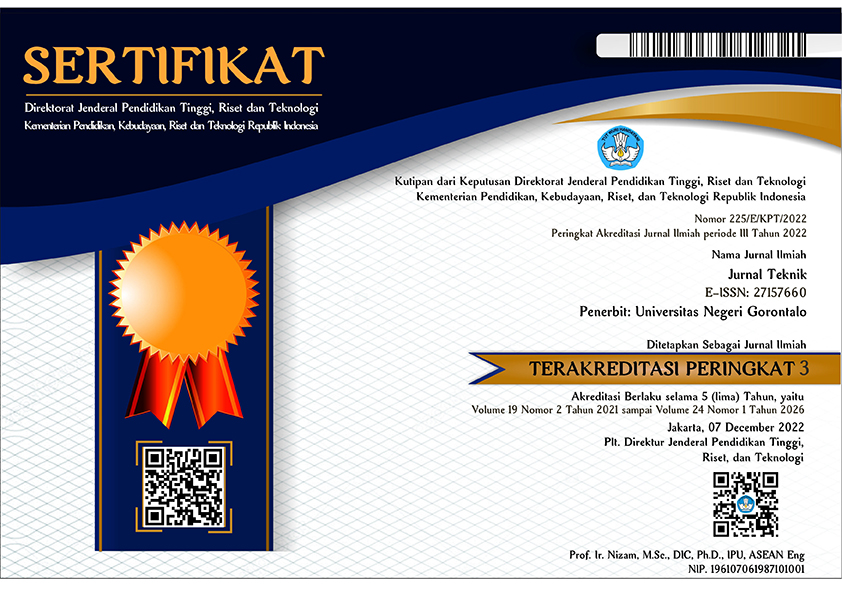Analisis Spasial Tingkat Bahaya Banjir Desa Amasing Kali Dengan Hec-RAS 2D
Abstract
The phenomenon of flooding that occurs in various parts of the world continues to increase, both in terms of frequency and amplitude. Without neglecting the morphology of the region, global climate change and changes in land use as a result of economic growth are the main factors causing this disaster. Understanding flood characteristics, be it discharge, inundation height, and their distribution in an area is very important as a basis for determining flood control efforts. This study aims to analyze the level of flood vulnerability based on the characteristics of the occurred floods. Hydrological and topographical analyzes were performed as the basis for the flow hydraulics calculations performed with Hec-RAS 2D version 5.0.7. The flood distribution simulation results with return periods of 2, 5, 10, and 25 years show that the area of the village that has the potential to be inundated is ± 22.57 ha, ± 37.11 ha, ± 41.81 ha, and ± 47.27 ha, with inundation heights varying between 0.25 m. – 1.50 m, which can be classified as low to high hazard.
Downloads
References
Al Amin, M., Ulfah, L., Haki, H. & Sarino, 2018. Simulasi Karakteristik Genangan Banjir Menggunakan Hec-RAS 5. Caantilever, pp. 13-24.
Avinash, K., Jayappa, K. & Deepika, B., 2011. Prioritization of sub-basins based on geomorphology and morphometric analysis using remote sensing and geographic information system (GIS) techniques. Geocarto International, pp. 569-592.
BNPB, 2020. Indeks Resiko Bencana Indonesia, s.l.: Badan Nasional Penanggulangan Bencana.
Brunner, G. W., 2016. HEC-RAS River Analysis System User's Manual Version 5. Davis, CA: US Army Corps of Engineers.
Carter, W., 1992. Disaster Management: Disaster Manager's Handbook. Manila: Asian Development Bank.
Irfan, R., Sujatmoko, B. & Siswanto, 2019. Analisis Daerah Genangan dan Bahaya Banjir di Sungai Kampar Kecamatan Kampar Utara. Pekanbaru, s.n., pp. 912-922.
MILT, 2005. Flood Hazard Mapping Manual in Japan, Japan: Ministry of Land Infrastructure and Transport.
Parsa, A. S., Noori, M., Heydari, M. & Mahmood, R., 2016. Floodplain Zoning Simulation by Using HEC-RAS and CCHE2D Models in the Sungai Maka River. Soil and Water Research, pp. 55-62.
Plate, E., 2002. Flood Risk and Flood Management. Journal Hydrology, pp. 2-11.
Rahayu, et al., 2009. Banjir dan Upaya Penanggulangannya. Bandung: PROMISE.
Rajeev & Singh, S., 2016. Watershed Management - A GIS Approach. International Journal of Research in Applied, Natural and Social Science (IMPACT: IJRANSS, pp. 109-116.
Rudra, R., Dickinson, W. & Sharma, D., 1993. Application GIS in Watershed Management. Journal of Water Management Modelling, pp. 469-482.
Safarina, A., Salim, H., Hadihardaja, I. & Syahril, B., 2011. Clusterization of Synthetic Unit Hydrograph Methods Based on Watershed Characteristics. International Journal of Civil & Environmental Engineering IJCEE-IJENS , 11(6).
Safaripour, M. et al., 2012. Flood Risk Assessment Using GIS (Case Study: Golestan Province, Iran). Pol. J. Environ. Stud., pp. 1817 - 1824.
Sarminingsih, A., 2018. Pemilihan Metode Analisis Debit Banjir Rancangan Embung Coyo Kabupaten Grobogan. Jurnal Presipitasi : Media Komunikasi dan Pengembangan Teknik Lingkungan, 15(1), pp. 53-61.
Supari, Tangang, F., Juneng, L. & Adria, E., 2016. Observed Changes in Extreme Temperature and Precipitation Over Indonesia. INTERNATIONAL JOURNAL OF CLIMATOLOGY.
Triatmodjo, B., 2008. Hidrologi Terapan. Yogyakarta: Beta Offset.
Vojtek, M. & Vojteková, J., 2019. Flood Susceptibility Mapping on a National Scale in Slovakia Using the Analytical Hierarchy Process. Water, pp. 1-17.
Harian Malut Post diakses pada laman https://issuu.com/malutpost/docs/malut_post__02_maret_2015/4
Republika.co.id diakses pada laman https://republika.co.id/berita/or1q9u383/Antara
Copyright (c) 2021 Ichsan Rauf (Author)

This work is licensed under a Creative Commons Attribution-ShareAlike 4.0 International License.













